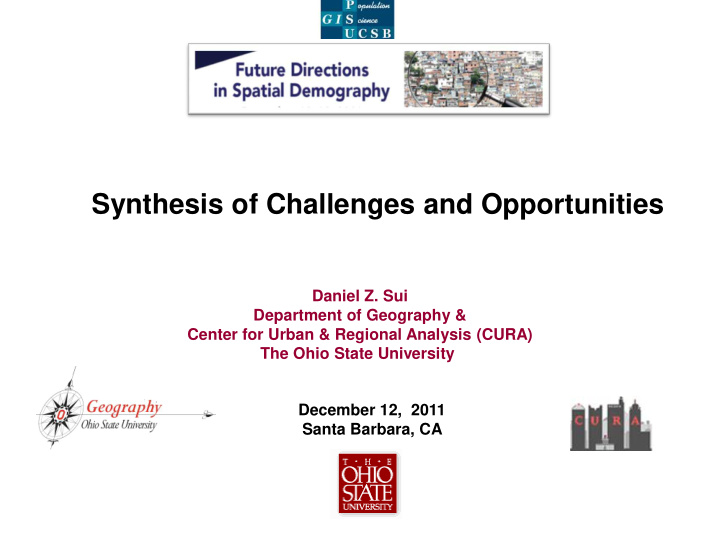



Synthesis of Challenges and Opportunities Daniel Z. Sui Department of Geography & Center for Urban & Regional Analysis (CURA) The Ohio State University December 12, 2011 Santa Barbara, CA
Two Cultures of Ecology Holling, C.S. 1998. Two cultures of ecology. Conservation Ecology [online] 2 (2): 4. Available from the Internet. URL: http://www.consecol.org/vol2/iss2/art4 • Analytical - Analysis • Integrative – Synthesis
Two Cultures of Ecology
Two cultures of GIScience: Analysis versus Synthesis? • Early GIS development emphasized the integration and synthesis of diverse sources of georeferenced information a top priority. • Spatial analysis has been at the forefront of GIScience between 1980 and 2010. • The growth of VGI & social media in the age of Web 2.0 has revitalized the goal of synthesis in GIS.
“Synthesis” in related technical fields • Data Assimilation (Spatial statistics/physical geography) • Data Fusion (Remote Sensing) • Data Conflation (Cartography/photogrammetry) • CyberGIS Framework (Geocomputation/CI)
GIS-based Synthesis: From overlay to mashup • Overlay (Early GIS) • Mashup (Web 2.0)
Synthesis: Opportunities • More diverse data available in real time • Multiple different methods • Complexity of problems
Multiple data acquisition methods
Synthesis of different types of data: Google Maps = Google in Maps Photo Video Text Social Activity More…
Child Beggar in China • Children as beggars prevail in China. • Kidnapped by traffickers, no census- registered/official
Spatial Distribution • Spatial Distribution based on amount of contributions in each province
Synthesis across scale: Linking geoinformatics with bioinformatics supramap.osu.edu
Global Digital Earth: e.g. Land Use From genetic Demographics Global Climate Sea Surface Temperature Digital Elevation e.g. to global Food and Fiber Disaster Preparedness Biodiversity Coastal Sensitivity e.g. Land Use/Land Cover Precision Agriculture Hydrologic Modeling Transportation Planning e.g. Smart Growth Public Health Disaster Response Weather A step closer Genetic to Total Information INDIVIDUAL Awareness? SCALE GENETIC SCALE
Synthesis: Opportunities • More diverse data available in real time • Multiple different methods • Complexity of problems
Crisis informatics: Univ. of Colorado
Synthesis: Challenges • Synthesis of space & place • Synthesis of space & time • Politics of synthesis: known & unknown • Synthesis of different problem domains • Educational challenges
Space: Vertical/Perpendicular View
Place: Perspective/side view
Multiple views
GIS Geomedia Video/photo
GIS: from mapping to media Text Sound Geomedia Video/photos
Synthesis: Challenges • Synthesis of space & place • Synthesis of space & time • Politics of synthesis: known & unknown • Synthesis of different problem domains • Educational challenges
Reconceptualing spatial demography: Beyond the chronochoric paradigm? • Two notions of space: – Choros – Topos • Two notions of time: – Chronos – Kairos
Spatial Demography: Towards a new synthesis?
Synthesis: Challenges • Synthesis of space & place • Synthesis of space & time • Synthesis of different problem domains • Politics of synthesis: known & unknown • Educational challenges
Synthesis: Challenges • Synthesis of space & place • Synthesis of space & time • Synthesis of different problem domains • Politics of synthesis: known & unknown • Educational challenges
[T]here are known knowns; there are things we know we know. We also know there are known unknowns; that is to say we know there are some things we do not know. But there are also unknown unknowns – the ones we don't know we don't know. ” — Former United States Secretary of Defense Donald Rumsfeld [T]here are unknown knowns - these are things that are known by the favored few, but unknown by many.
Synthesis across aggregated (encrypted) vs. individual (confidential) data • Homomorphic cyptography for confidentiality protection
Educational Challenges
• Gardner: A synthesizing mind Narrative Taxonomy Complex concept Rules and aphorism Powerful metaphors, images, and themes Embodiments without words Theory Metatheory
Narratives : Tropes of appeal • Romance • Comedy • Tragedy • Irony
the ancient Greek poet Archilochus: ("the fox knows many little things, but the hedgehog knows one big thing"). Berlin expands upon this idea to divide writers and thinkers into two categories: hedgehogs, who view the world through the lens of a single defining idea (examples given include Plato, Lucretius, Dante, Pascal, Hegel, Dostoevsky, Nietzsche, Ibsen, and Proust) and foxes who draw on a wide variety of experiences and for whom the world cannot be boiled down to a single idea (examples given include Herodotus, Aristotle, Erasmus, Shakespeare, Montaigne, Molière, Goethe, Pushkin, Balzac, Joyce, Anderson).
a. quantitative vs. qualitative b. place vs. space c. local vs. global d. men vs. women Figure 1. Trends of four geographical themes as revealed by N-gram
Recommend
More recommend